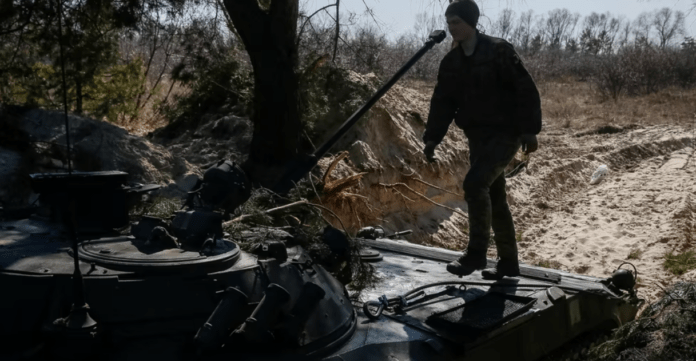America has become too accustomed to thinking of its side as stymied, ineffective, or incompetent.
About the author: Eliot A. Cohen is a contributing writer at The Atlantic, a professor at The Johns Hopkins University School of Advanced International Studies, and the Arleigh Burke chair in strategy at CSIS. From 2007 to 2009, he was the Counselor of the Department of State. He is the author most recently of The Big Stick: The Limits of Soft Power and the Necessity of Military Force.
When i visited iraq during the 2007 surge, I discovered that the conventional wisdom in Washington usually lagged the view from the field by two to four weeks. Something similar applies today. Analysts and commentators have grudgingly declared that the Russian invasion of Ukraine has been blocked, and that the war is stalemated. The more likely truth is that the Ukrainians are winning.
So why can’t Western analysts admit as much? Most professional scholars of the Russian military first predicted a quick and decisive Russian victory; then argued that the Russians would pause, learn from their mistakes, and regroup; then concluded that the Russians would actually have performed much better if they had followed their doctrine; and now tend to mutter that everything can change, that the war is not over, and that the weight of numbers still favors Russia. Their analytic failure will be only one of the elements of this war worth studying in the future.
At the same time, there are few analysts of the Ukrainian military—a rather more esoteric specialty—and thus the West has tended to ignore the progress Ukraine has made since 2014, thanks to hard-won experience and extensive training by the United States, Great Britain, and Canada. The Ukrainian military has proved not only motivated and well led but also tactically skilled, integrating light infantry with anti-tank weapons, drones, and artillery fire to repeatedly defeat much larger Russian military formations. The Ukrainians are not merely defending their strong points in urban areas but maneuvering from and between them, following the Clausewitzian dictum that the best defense is a shield of well-directed blows.
The reluctance to admit what is happening on the ground in Ukraine stems perhaps in part from the protectiveness scholars feel for their subject (even if they loathe it on moral grounds), but more from a tendency to emphasize technology (the Russians have some good bits), numbers (which they dominate, though only up to a point), and doctrine. The Russian army remains in some ways very cerebral, and intellectuals can too easily admire elegant tactical and operational thinking without pressing very hard on practice. But the war has forcibly drawn attention to the human dimension. For example, most modern militaries rely on a strong cadre of noncommissioned officers. Sergeants make sure that vehicles are maintained and exercise leadership in squad tactics. The Russian NCO corps is today, as it has always been, both weak and corrupt. And without capable NCOs, even large numbers of technologically sophisticated vehicles deployed according to a compelling doctrine will end up broken or abandoned, and troops will succumb to ambushes or break under fire.
The West’s biggest obstacle to accepting success, though, is that we have become accustomed over the past 20 years to think of our side as being stymied, ineffective, or incompetent. It is time to get beyond that, and consider the facts that we can see.
The evidence that Ukraine is winning this war is abundant, if one only looks closely at the available data. The absence of Russian progress on the front lines is just half the picture, obscured though it is by maps showing big red blobs, which reflect not what the Russians control but the areas through which they have driven. The failure of almost all of Russia’s airborne assaults, its inability to destroy the Ukrainian air force and air-defense system, and the weeks-long paralysis of the 40-mile supply column north of Kyiv are suggestive. Russian losses are staggering—between 7,000 and 14,000 soldiers dead, depending on your source, which implies (using a low-end rule of thumb about the ratios of such things) a minimum of nearly 30,000 taken off the battlefield by wounds, capture, or disappearance. Such a total would represent at least 15 percent of the entire invading force, enough to render most units combat ineffective. And there is no reason to think that the rate of loss is abating—in fact, Western intelligence agencies are briefing unsustainable Russian casualty rates of a thousand a day.
Add to this the repeated tactical blundering visible on videos even to amateurs: vehicles bunched up on roads, no infantry covering the flanks, no closely coordinated artillery fire, no overhead support from helicopters, and panicky reactions to ambushes. The 1-to-1 ratio of vehicles destroyed to those captured or abandoned bespeaks an army that is unwilling to fight. Russia’s inability to concentrate its forces on one or two axes of attack, or to take a major city, is striking. So, too, are its massive problems in logistics and maintenance, carefully analyzed by technically qualified observers.
The Russian army has committed well more than half its combat forces to the fight. Behind those forces stands very little. Russian reserves have no training to speak of (unlike the U.S. National Guard or Israeli or Finnish reservists), and Putin has vowed that the next wave of conscripts will not be sent over, although he is unlikely to abide by that promise. The swaggering Chechen auxiliaries have been hit badly, and in any case are not used to, or available for, combined-arms operations. Domestic discontent has been suppressed, but bubbles up as brave individuals protest and hundreds of thousands of tech-savvy young people flee.
If Russia is engaging in cyberwar, that is not particularly evident. Russia’s electronic-warfare units have not shut down Ukrainian communications. Half a dozen generals have gotten themselves killed either by poor signal security or trying desperately to unstick things on the front lines. And then there are the negative indicators on the other side—no Ukrainian capitulations, no notable panics or unit collapses, and precious few local quislings, while the bigger Russophilic fish, such as the politician Viktor Medvedchuk, are wisely staying quiet or out of the country. And reports have emerged of local Ukrainian counterattacks and Russian withdrawals.
The coverage has not always emphasized these trends. As the University of St. Andrews’s Phillips P. O’Brien has argued, pictures of shattered hospitals, dead children, and blasted apartment blocks accurately convey the terror and brutality of this war, but they do not convey its military realities. To put it most starkly: If the Russians level a town and slaughter its civilians, they are unlikely to have killed off its defenders, who will do extraordinary and effective things from the rubble to avenge themselves on the invaders. That is, after all, what the Russians did in their cities to the Germans 80 years ago. More sober journalism—The Wall Street Journal has been a standout in this respect—has been analytic, offering detailed reporting on revealing battles, like the annihilation of a Russian battalion tactical group in Voznesensk.
Most commentators have taken too narrow a view of this conflict, presenting it as solely between Russia and Ukraine. Like most wars, though, it is being waged by two coalitions, fought primarily though not exclusively by Russian and Ukrainian nationals. The Russians have some Chechen auxiliaries who have yet to demonstrate much effectiveness (and who lost their commander early on), may get some Syrians (who will be even less able to integrate with Russian units), and find a half-hearted ally in Belarus, whose citizens have begun sabotaging its rail lines and whose army may well mutiny if asked to invade Ukraine.
The Ukrainians have their auxiliaries, too, some 15,000 or so foreign volunteers, some probably worthless or dangerous to their allies, but others valuable—snipers, combat medics, and other specialists who have fought in Western armies. More important, they have behind them the military industries of countries including the United States, Sweden, Turkey, and the Czech Republic. Flowing into Ukraine every day are thousands of advanced weapons: the best anti-tank and anti-aircraft missiles in the world, plus drones, sniper rifles, and all the kit of war. Moreover, it should be noted that the United States has had exquisite intelligence not only about Russia’s dispositions but about its intentions and actual operations. The members of the U.S. intelligence community would be fools not to share this information, including real-time intelligence, with the Ukrainians. Judging by the adroitness of Ukrainian air defenses and deployments, one may suppose that they are not, in fact, fools.
Talk of stalemate obscures the dynamic quality of war. The more you succeed, the more likely you are to succeed; the more you fail, the more likely you are to continue to fail. There is no publicly available evidence of the Russians being able to regroup and resupply on a large scale; there is plenty of evidence to the contrary. If the Ukrainians continue to win, we might see more visible collapses of Russian units and perhaps mass surrenders and desertions. Unfortunately, the Russian military will also frantically double down on the one thing it does well—bombarding towns and killing civilians.
The Ukrainians are doing their part. Now is the time to arm them on the scale and with the urgency needed, as in some cases we are already doing. We must throttle the Russian economy, increasing pressure on a Russian elite that does not, by and large, buy into Vladimir Putin’s bizarre ideology of “passionarity” and paranoid Great Russian nationalism. We must mobilize official and unofficial agencies to penetrate the information cocoon in which Putin’s government is attempting to insulate the Russian people from the news that thousands of their young men will come home maimed, or in coffins, or not at all from a stupid and badly fought war of aggression against a nation that will now hate them forever. We should begin making arrangements for war-crimes trials, and begin naming defendants, as we should have done during World War II. Above all, we must announce that there will be a Marshall Plan to rebuild the Ukrainian economy, for nothing will boost their confidence like the knowledge that we believe in their victory and intend to help create a future worth having for a people willing to fight so resolutely for its freedom.
As for the endgame, it should be driven by an understanding that Putin is a very bad man indeed, but not a shy one. When he wants an off-ramp, he will let us know. Until then, the way to end the war with the minimum of human suffering is to pile on.




